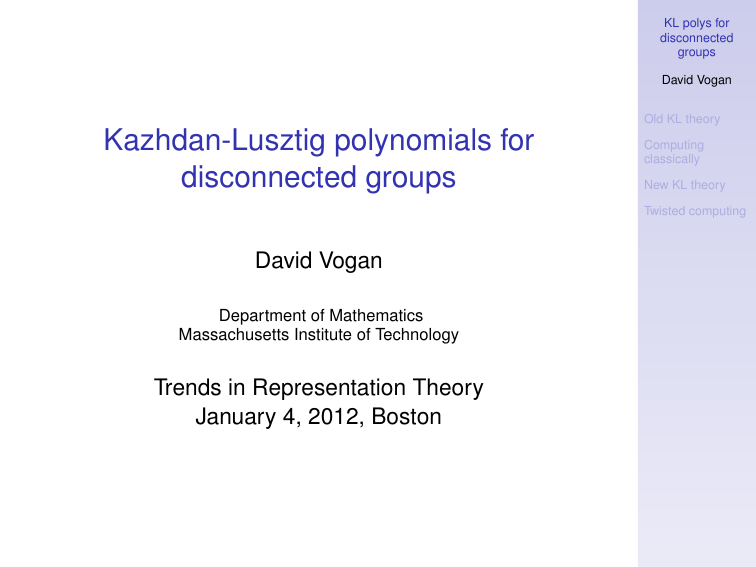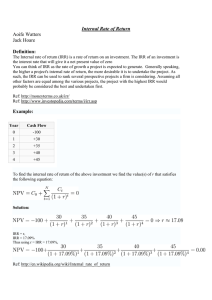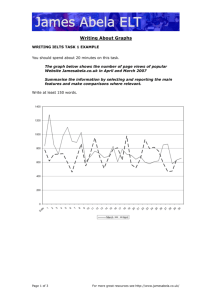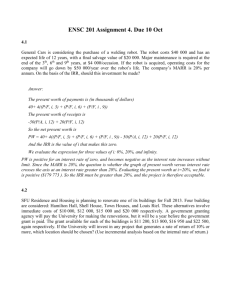Kazhdan-Lusztig polynomials for disconnected groups David Vogan Trends in Representation Theory
advertisement

KL polys for
disconnected
groups
David Vogan
Old KL theory
Kazhdan-Lusztig polynomials for
disconnected groups
Computing
classically
New KL theory
Twisted computing
David Vogan
Department of Mathematics
Massachusetts Institute of Technology
Trends in Representation Theory
January 4, 2012, Boston
Outline
KL polys for
disconnected
groups
David Vogan
Old KL theory
What are KL polynomials for?
Computing
classically
New KL theory
Twisted computing
How to compute KL polynomials
Twisting by outer automorphisms
Computing twisted KL polynomials
Making repn theory algebraic
KL polys for
disconnected
groups
David Vogan
G conn reductive alg gp def over R
Natural problem: Describe irr repns (π, Hπ ) of G(R).
Function-analytic: Hπ is Hilbert space.
To do algebra: fix K (R) ⊂ G(R) max compact.
Analytic reps of K (R) = algebraic reps of K (Weyl’s
unitarian trick)
HπK = K (R)-finite vecs in Hπ HC module of π
Harish-Chandra: HπK is (g, K )-module (alg rep of
g = Lie(G) with compatible alg rep of K ).
HC: analytic G(R) reps = algebraic (g, K )-mods.
Π(G(R)) = Π(g, K ) = equiv classes of irr mods.
Old KL theory
Computing
classically
New KL theory
Twisted computing
From (g, K )-mods to constructible sheaves
X = flag var of G,
d = dim X = #(pos roots)
KL polys for
disconnected
groups
David Vogan
= variety of Borel subalgebras of g = Lie(G)
Old KL theory
X is “universal boundary” for G-homog spaces.
First made precise by Helgason conj
(Kashiwara-Kowata-Minemura-Okamoto-Oshima-Tanaka).
Beilinson-Bernstein loc thm: any rep (more or less)
appears in secs of (more or less) eqvt line bundle on X .
Which bundle ! infl char = action of cent of U(g).
Example: F fin diml irr rep of G
at b = h + n is lowest wt space
LF ,b = F /nF = H0 (n, F );
line bdle LF → X ; fiber
F = alg secs of LF
V fin length (g, K )-mod
HF (V ) ∈ K -eqvt derived
category of constructible sheaves on X .
Cohom HFi (V ) is K -eqvt constr sheaf on X ; fiber is
HFi (V )b = Homh (F /nF , Hi+d (n, V )).
Computing
classically
New KL theory
Twisted computing
Irreducible modules and perverse sheaves
Given irr fin-diml rep F of G, have a functor HF from finite
length (g, K )-mods to K -eqvt derived category of constr
sheaves on flag var X .
1970s: for V irr, HF (V ) 6= 0 if (Harish-Chandra,
Langlands, Schmid) and only if (Casselman-Osborne) V
has same infl char as F .
Theorem (Beilinson-Bernstein, Kashiwara/Mebkhout,. . . )
Map V → HF (V ) is bijection from irr (g, K )-mods, infl char of F
to irr K -eqvt perverse sheaves on X .
irr K -eqvt perverse sheaves on X
↔ pairs (O, S) (K -orbit on X , irr eqvt local system)
n
o
↔ (B, σ) | B ⊂ G Borel, σ ∈ (B ∩ K )/(B ∩ K )b0 /K
n
o
↔ (H, ∆+ , σ) | H θ-stable CSG, σ ∈ (H ∩ K )/(H ∩ K )b0 /K
n
o
↔ (H(R), ∆+ , σ) | H(R) real CSG, σ ∈ H(R)/H(R)b0 /G(R).
KL polys for
disconnected
groups
David Vogan
Old KL theory
Computing
classically
New KL theory
Twisted computing
What KL polys tell you
KL polys for
disconnected
groups
David Vogan
ΠF (G(R)) = params for irr reps, infl char of F
= (H(R), ∆+ , σ) /G(R).
x ∈ ΠF (G(R))
I(x) standard rep (like Verma
module), J(x) irr quotient.
Recall d = dim X ; put dx = dim(K -orbit for x).
HF (I(x)) = loc sys S(x)[dx ] on one K -orbit
HF (J(x)) = perverse extension P(x)
Coeff of t i in KL poly Py ,x is
mult of loc sys S(y ) in cohom P−dx +2i (x).
= mult of σy in Homhy (F /ny F , H(d−dx )+2i (ny , J(x))).
X
J(x) =
Py ,x (1)(−1)dy −dx I(y ).
y ≤x
Old KL theory
Computing
classically
New KL theory
Twisted computing
The Hecke algebra
KL polys for
disconnected
groups
David Vogan
Interested in category M(X , K ) of K -eqvt perverse
sheaves on X .
Old KL theory
Analogue over finite field Fq : vector space
Computing
classically
M(X , K )q = {K (Fq )-invt functions on X (Fq )}.
This vec space is module for Hecke algebra at q
Hq = {G(Fq )-invt functions on X (Fq )}.
M(X , K ) ind of field; irrs are ratl /Fq .
Frobenius F is alg aut of G, K , X . . . Fixed pts =
Fq -ratl points.
Alt sum of traces of F on fibers of cohomology
sheaves at rational points maps (ratl) objects of
M(X , K ) to M(X , K )q .
Lusztig: relate Hq action to geometry of perverse
sheaves
compute Py ,x .
New KL theory
Twisted computing
KL polys for
disconnected
groups
Disconnected groups
Want to consider G0 ⊃ G, G0 /G finite.
Rep theory for finite groups harder than for Lie groups,
because Lie algebra linearizes problems.
So “arbitrary” disconnected reductive G0 ⊃ G too hard.
Easy/useful special case: G0 /G finite cyclic.
Action of G0 on G
candidates corr to
1 → Int(G) → Aut(G) → Out(G) → 1
Fix G ⊃ Bp ⊃ Hp
Πp simple roots, root datum
∗
(X (Hp ), Πp , X∗ (Hp ), Π∨
p ).
Pinning p is Bp ⊃ Hp plus choice of maps
φp (α) : SL(2) → G,
α ∈ Πp .
Now automorphism group sequence split by
Autp (G) =def auts permuting {φp }
' root datum automorphisms ' Out(G).
David Vogan
Old KL theory
Computing
classically
New KL theory
Twisted computing
Pinned disconnected groups
KL polys for
disconnected
groups
David Vogan
Cplx conn reductive G, pinning p, Cartan inv θ preserves
Hp ⊂ Bp (fundamental), almost permutes {φp }.
Fix order two root datum aut δ
δp ∈ Autp (G0 ).
Order two not critical, but easier and covers current applications.
Old KL theory
Computing
classically
New KL theory
Twisted computing
G∆ =def G o {1, δp } our model disconn reductive group.
δp θ = θδp , so δp normalizes K ; K ∆ =def K o {1, δp }.
Ex: δ induced by θ, so θ = Ad(t)δp (t ∈ Hp ∩ K ).
Ex: G = SO(2n, C), Hp = SO(2, C)n ,
θ = Ad(diag(1, . . . , 1, −1, . . . , −1, 1, −1))
(2p + 1 1s, 2q + 1 −1s); means
G(R) ' SO(2p + 1, 2q + 1). Have
δp = Ad(diag(1, . . . , 1, −1));
so G∆ ' O(2n, C).
KL polys for
disconnected
groups
Reps of pinned disconnected groups
G∆ =def G o {1, δp }, K ∆ =def K o {1, δp }.
David Vogan
δp
V any (g, K )-module
V same vector space; actions of
g, K twisted by δp . Gives action of ∆ on Π(g, K ).
∆
First way to make irr (g, K )-module: start with V 6' V
irr, V ∆ = V ⊕ V δp . Gives bijection
δp
Old KL theory
Computing
classically
New KL theory
Twisted computing
V ∆ ∈ Π(g, K ∆ ) reducible on (g, K )
↔ two-elt orbits {V , V δp } of ∆ on Π(g, K ).
Second way to make irr (g, K ∆ )-module: start with
V ' V δp irr; choose intertwining op
Dp : V → V δp ,
Dp2 = Id
(two choices diff by sgn). Extend V to V ∆ , making δp act
by Dp . Gives 2-to-1 map
elts V ∆ of Π(g, K ∆ ) irr on (g, K )
↔ fixed pts V of ∆ on Π(g, K ).
Application of disconnected groups
KL polys for
disconnected
groups
David Vogan
δ root datum aut induced by Cartan inv θ.
δ is trivial iff rk G = rk K .
Theorem (consquence of Knapp-Zuckerman)
V irr (g, K )-mod of real infl char. Then V admits invt
Hermitian form iff V ' V δ .
Corollary (Adams-van Leeuwen-Trapa-V-Yee)
Every irr (g, K ∆ )-mod V ∆ of real infl char admits
preferred invt Hermitian form.
Case V ∆ = V ⊕ V δp : form “hyperbolic,” V isotropic.
Case V ∆
V irr: V admits invt Herm form. Two
∆
exts V to (g, K ∆ )-mod ! two invt forms on V .
Relate invt forms on irrs to invt forms on std modules
! compute char formulas for (g, K ∆ )-mods.
Old KL theory
Computing
classically
New KL theory
Twisted computing
Classifying irr mods for pinned disconn gps
KL polys for
disconnected
groups
David Vogan
F fin-diml irr of G, lowest weight λp ∈ X ∗ (Hp ).
Old KL theory
Twist F δp = irr of lowest weight δλp ; isom to F iff λp is
fixed by root datum aut δ.
Case F 6' F δp : no irr of infl char F has invt Herm form; irr
(g, K ∆ )-mods all induced from irr (g, K )-mods.
Case F ' F δp : fix canonical extension F ∆ of F to G∆ rep,
δp acts triv on Bp -lowest wt space.
Get G∆ -eqvt alg line bdle LF ∆ on X .
Localization + Riemann-Hilbert gives functor HF ∆ from fin
length (g, K ∆ )-mod to K ∆ -eqvt derived category of constr
sheaves on X .
Theorem (Beilinson-Bernstein, Kashiwara/Mebkhout,. . . )
Map V ∆ → HF ∆ (V ∆ ) is bijection from irr (g, K ∆ )-mods, infl
char of F ∆ to irr K ∆ -eqvt perverse sheaves on X .
Computing
classically
New KL theory
Twisted computing
K ∆ -eqvt irr perverse sheaves
B ⊂ G Borel
B ∆ = NG∆ (B).
KL polys for
disconnected
groups
David Vogan
K ∆ preserves K · b ⇔ B ∩ K index two in B ∆ ∩ K ∆
⇔ B ∆ \ B meets K ∆ \ K in elt d
K -eqvt loc sys Sσ extends to K ∆ -eqvt
⇔ automorphism d fixes char σ of (B ∩ K )/(B ∩ K )0 .
∆
First way to make irr K -eqvt perverse sheaf: start with
P 6' Pδp irr, P∆ = P ⊕ Pδp .
Built from local systems on orbits via classical KL polys.
Second way to make irr K ∆ -eqvt perverse sheaf: start
with P ' Pδp irr; choose isom
Dp : P → Pδp , Dp2 = Id
(two choices diff by sgn). Make δp act by Dp ; P K ∆ -eqvt.
“First way” local systems in P ! classical KL polys.
New KL polys Pyδ,x : x, y K ∆ -eqvt loc systems irr for K .
Coeff of t i in Pyδ,x is
mult[local sys S(y )] − mult[local sys S(−y )] in P−dx +2i (x).
Old KL theory
Computing
classically
New KL theory
Twisted computing
KL polys for
disconnected
groups
The twisted Hecke algebra
M(X , K ∆ ) = K ∆ -eqvt perverse sheaves on X .
Over Fq : use Frobenius map F twisted by δp to get
quasisplit form G(Fq ) ⊃ K (Fq )
Easy Fq -analogue of perverse sheaves is
M(X , K ∆ )q = {K (Fq )-invt functions on X (Fq )}.
This vec space is module for Lusztig’s quasisplit Hecke
algebra at q
Hqδ = {G(Fq )-invt functions on X (Fq )}.
Basis indexed by W δ = fixed subgp of root datum aut on
W ; gens indexed by Πp /∆, aut orbits of simple roots.
Relations involve dimensions of “restricted root” subgps:
(very particular) unequal parameter Hecke algebra.
Alt sum of traces of F on fibers of cohom sheaves at ratl
pts maps (ratl) objects of M(X , K ) to M(X , K )q .
Lusztig: relate Hqδ action to geom
compute Pyδ,x .
David Vogan
Old KL theory
Computing
classically
New KL theory
Twisted computing






